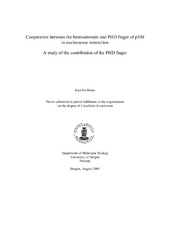Cooperation between the bromodomain and PHD finger of p300 in nucleosome interaction. A study of the contribution of the PHD finger
Master thesis
Permanent lenke
https://hdl.handle.net/1956/3482Utgivelsesdato
2003-08Metadata
Vis full innførselSamlinger
Sammendrag
The different cells in an organism need to know which genes to be active and which to be inactive. A central mechanism that contributes to regulate gene expression is the organisation of DNA into dense and less dense forms. This form of epigenetic gene regulation can be brought about by the attachment of epigenetic marks to chromatin. Epigenetic marks can be copied to daughter cells. Some of these marks are also inherited, through germ cells, to a new generation. Proteins exist that can recognize the epigenetic marks. A protein domain present in several proteins implicated in chromatin mediated gene regulation is the PHD finger, but so far, no such evidence has been provided confirming that the PHD finger can actually interact with chromatin. The PHD finger often occurs next to one or more other domains, some of which have known chromosome-binding activities. In the cofactor p300, the PHD finger occurs next to a bromodomain. The region of p300 including both of these domains (p300BP) is found to bind to acetylated mononucleosomes in vitro and that the PHD finger is essential for the interaction. In this study, the relation between the domains was investigated to examine the contribution of the PHD finger. Recombinant proteins were made by swapping the PHD finger in p300BP with a PHD finger from a heterologous protein, but no nucleosome interaction was detected with the recombinant proteins. p300BP, and probably also the protein p300, therefore seems to be dependent on a specific interaction between its bromodomain and PHD finger to give a functional protein able to interact with nucleosomes.
Utgiver
The University of BergenOpphavsrett
The authorCopyright the author. All rights reserved
